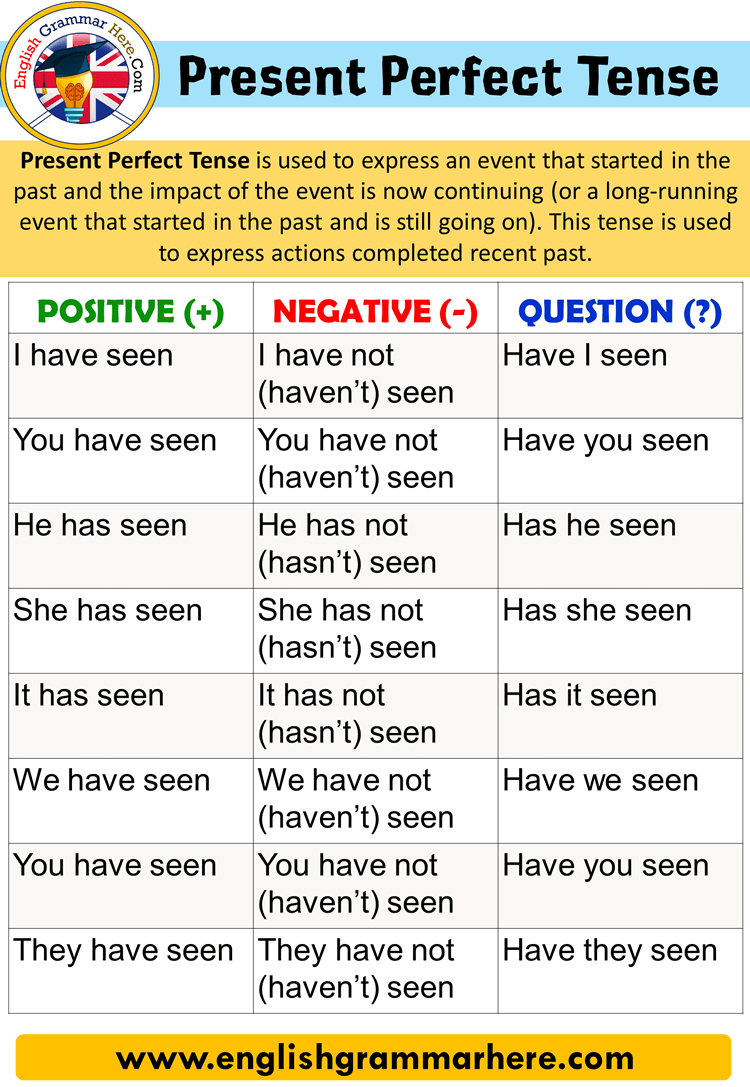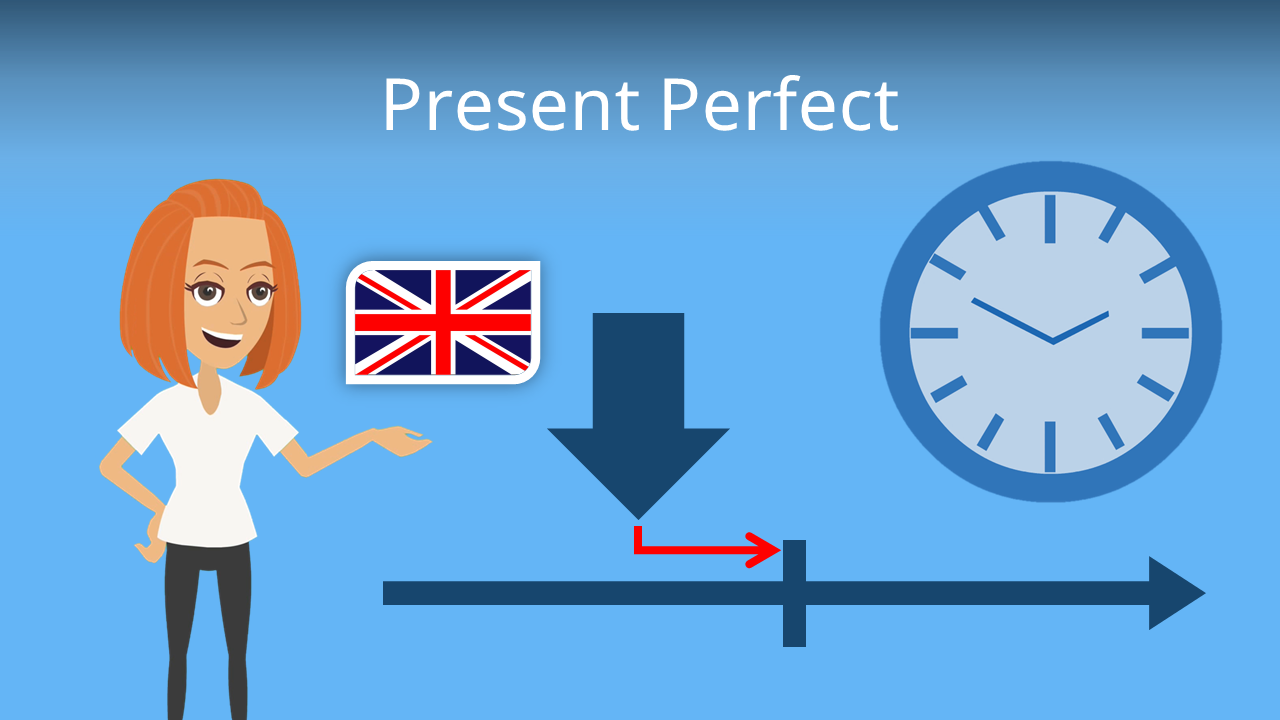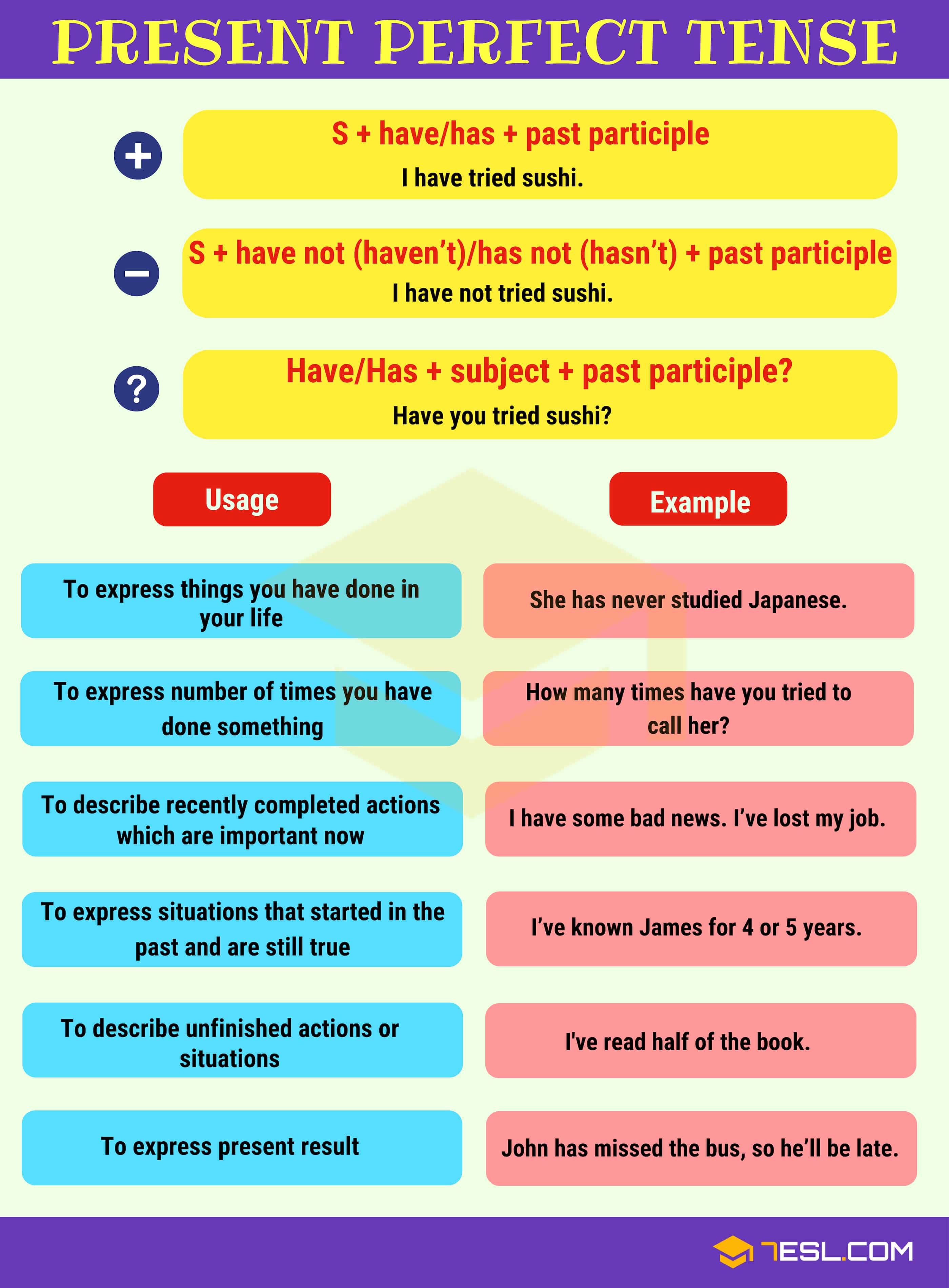
Structure of Present Perfect Tense English Study Page
To make the positive present perfect tense, use: 'have' / 'has' + the past participle. Make the past participle by adding 'ed' to regular verbs (for example, 'play' becomes 'played') There are a few verbs that change their spelling when you add 'ed' (for example, 'study' becomes 'studied') We also have some completely irregular verbs.

PRESENT PERFECT / Basics, Verneinung & Fragen erklärt + Übungen Englisch YouTube
The Oxford Learner's Dictionary defines the present perfect tense as "the form of a verb that expresses an action done in a time period up to the present, formed in English with the present tense of 'have' and the 'past participle' of the verb, as in I have eaten ."

Present Perfect Tense, Using and Examples English Grammar Here
The present perfect is a verb tense which is used to show that an action has taken place once or many times before now. The present perfect is most frequently used to talk about experiences or changes that have taken place, but there are other less common uses as well. Read on for detailed descriptions, examples, and present perfect exercises.

Pin on Schulnotizen
The present perfect tense is a verb form used to refer to a past action or situation that has a present consequence. It's typically used to indicate experience up to the present, recent actions, or a change that occurred over a period of time.

Frage und Verneinung im Present Perfect Unterrichtsmaterial im Fach Englisch Fragen
Verbs Present tense Present perfect Present perfect Level: beginner The present perfect is formed from the present tense of the verb have and the past participle of a verb. We use the present perfect: for something that started in the past and continues in the present: They've been married for nearly fifty years.

Contoh Kalimat Simple Present Perfect Tense Berbagai Contoh
1. be als Vollverb 2. do als Vollverb 3. have als Vollverb Bei bejahten Sätzen und der Verneinung können für have (has) natürlich auch die Kurzformen stehen. Erläuterungen Present Perfect (Kurzübersicht) be, do, have im Present Perfect Fragen im Present Perfect Kurzformen und Langformen im Present Perfect Du befindest dich hier: Start

Grammar present perfect progressive. Worksheet and solution meinUnterricht
The present perfect tense is an English verb tense used for past actions that are related to or continue into the present. It's easily recognized by the auxiliary verbs (or helper verbs) have and has, as in, "I have gone fishing since I was a child."

PRESENT PERFECT Merkblatt (mehrere Versionen) Unterrichtsmaterial im Fach Englisch
More Examples of the Present Perfect Tense. Here are some more examples of the present perfect tense: The board has decided to uphold the appeal. (This sentence carries the connotation that the board continues to uphold the appeal.) I have taken the wrong path. (Connotation: I am still on the wrong path.)

Englisch Present Perfect Übersicht Unterrichtsmaterial im Fach Englisch Englisch
1. Für Handlungen, die bis in die Gegenwart reichen. I have lived in Hamburg since 2010. - Ich lebe seit 2010 in Hamburg (und lebe immer noch dort). 2. Für Handlungen, die noch eine direkte Auswirkung auf die Gegenwart haben. Are you hungry? - No, I've just eaten. - Hast du Hunger? - Nein, ich habe gerade gegessen (und bin deshalb satt). 3.

Tandem Activity / Tandembögen zu Aussagen und Verneinungen im Present Perfect
Das present perfect simple wird dann verwendet, wenn ein Ereignis in der Vergangenheit begonnen hat und eine Verbindung zu Gegenwart besteht.. Verneinung. I, you, we, they - have not (haven't) + 3rd form. he, she, it - has not (hasn't) + 3rd form. They haven't tidied up their room so far. - He hasn't finished his homework yet. Fragen. Have.

Das present perfect einfach erklärt Einfach Englisch YouTube
The affirmative form of the Present Perfect Tense is used to express an action or event that has occurred at an unspecified time in the past or that began in the past and continues to the present. The structure of the affirmative form is as follows: Subject + have/has + past participle of the verb. Examples:

Present Perfect • Bildung, Verwendung & Beispielsätze · [mit Video]
Present Perfect with for and since. The present perfect is also used with for and since to talk about actions that began in the past and continue to the present. "I've lived here since 2004." "I've lived here for 8 years." Since is used with a point in time, and means "from that point in time until the present."Use since with dates (2011, January, Tuesday, etc.), times (6:15.

Present Perfect Tense Definition, Examples, & Rules» OnlyMyEnglish
Übung 4. Markiere die richtige Aussage zur Verneinung im Present Perfect. Im Present Perfect muss ich für eine Verneinung not vor have / has einfügen. Im Present Perfect können bei der Verneinung keine Kurzformen benutzt werden. Im Present Perfect können bei der Verneinung Kurzformen benutzt werden: haven't / hasn't.

Englisch present perfect since for Übungskarten Unterrichtsmaterial im Fach Englisch
Present Perfect, Verneinungen, Grammatikübungen, Englisch Lernen, Übungen. Aufgaben-Nr. 4154Setze das Verb in Klammern in die Lücke und bilde verneinte Aussagesätze im Present Perfect.. Beispiel aufklappen

Present Perfect Tense Definition, Rules and Useful Examples Effortless English
The Present Perfect tense is a rather important tense in English, but it gives speakers of some languages a difficult time. That is because it uses concepts or ideas that do not exist in those languages. In fact, the structure of the Present Perfect is very simple. The problems come with the use of the tense.

Present Perfect Arbeitsblätter mit Lösungen Arbeitsblatt Englisch 6 Englisch nachhilfe
Present Perfect: Aussage, Frage, Verneinung (mit Untertiteln) - YouTube 0:00 / 4:49 Eine kurze und einfache Erklärung zur Bildung und Verwendung von Present Perfect.Click it, like it,.